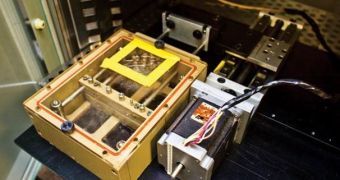Scientists at the University of Pennsylvania are currently working on a new approach to producing resilient transplants. The method involves mechanically stretching living nerve cells inside a special, custom-built machine. The goal of this investigation is to produce new treatments for conditions that are currently thought to be incurable, such as paralysis. What the UP team is attempting to do is create nerve strands that would be able to bypass an injury site, or to redirect nerve impulses around an affected area, Technology Review reports.
The new work is conducted by the Director of the UP Center for Brain Injury and Repair, Douglas Smith, who is also a professor at the university. Inside plastic dishes, the researchers are currently growing dozens of thin, hair-like filaments. These structures connect pairs from two rows of tiny, black dots, and Smith explains that they are in fact bundles containing thousands of neurons. The filaments are actually made out of axons, which are the long, dendritic extensions of nerve cells. They conduct electrical impulses through electrical potential differences, and are extremely good at it too.
Fixing the damages caused by a severe wound to nerve cells is a race against time, Smith says. The cells take about a day to grow a millimeter, so they need a long time to link up with the rest of the group, located beyond the site of a wound. A larger wound naturally means a lot more time, but the sheath that protects neurons and helps them transmit impulses disappears within three months or so, if it doesn't have any cells inside. Until now, not even the most advanced techniques have been able to restore function to areas that were too far away from an injury site. A shoulder wound, for example, almost never heals in time, and patients lose the full function of their affected arms.
With the new, mechanical approach, the nerve cells can be made to grow about 100 times faster than they would normally, the UP team reports. This is wonderful news for patients, as they could benefit from this new form of treatment pretty soon. In addition, the new neurons also help other naturally growing ones find their way to the exact place where a connection with the severed nerve cells needs to be done. In rats that had parts of their leg muscles cut out, the healing process took about four months. Naturally, more investigations into this matter will see that time reduced even further, Smith says.

 14 DAY TRIAL //
14 DAY TRIAL //